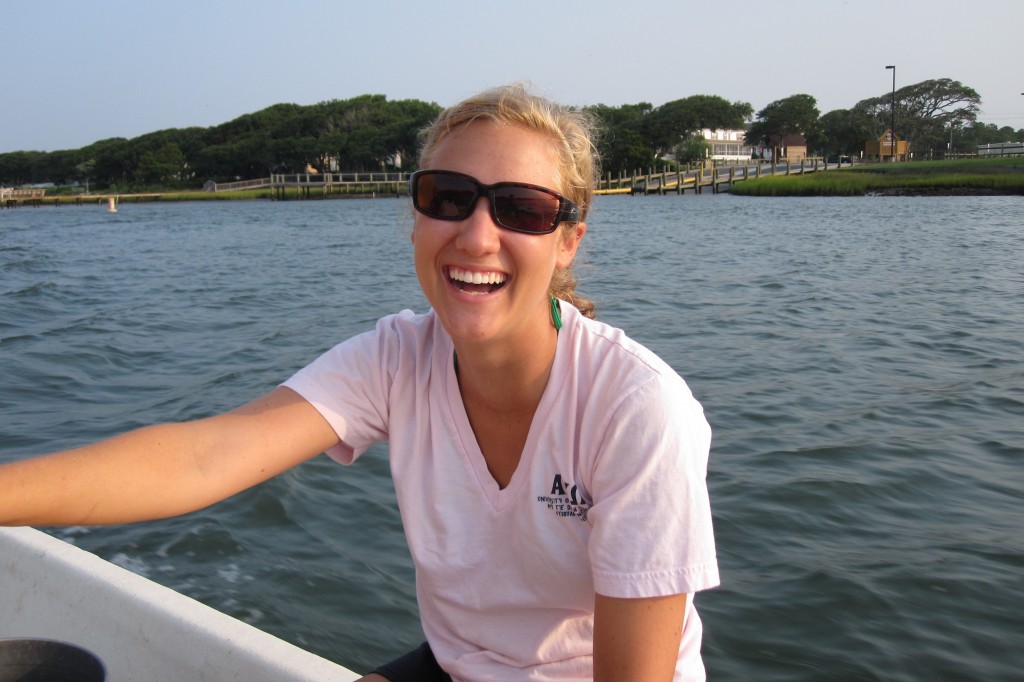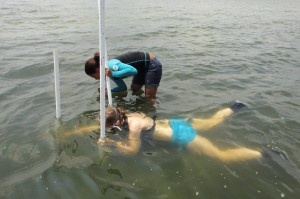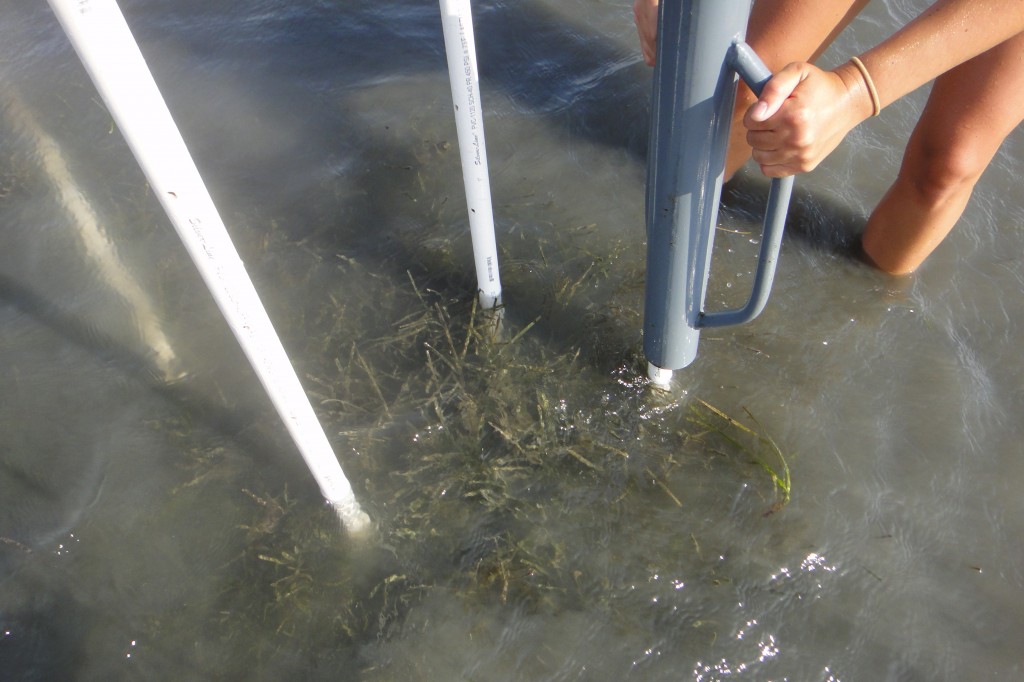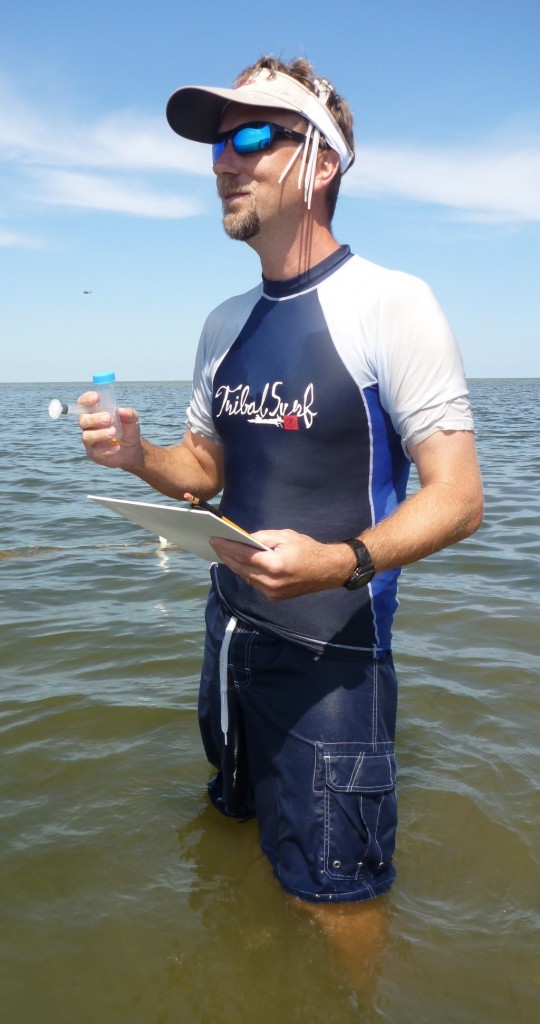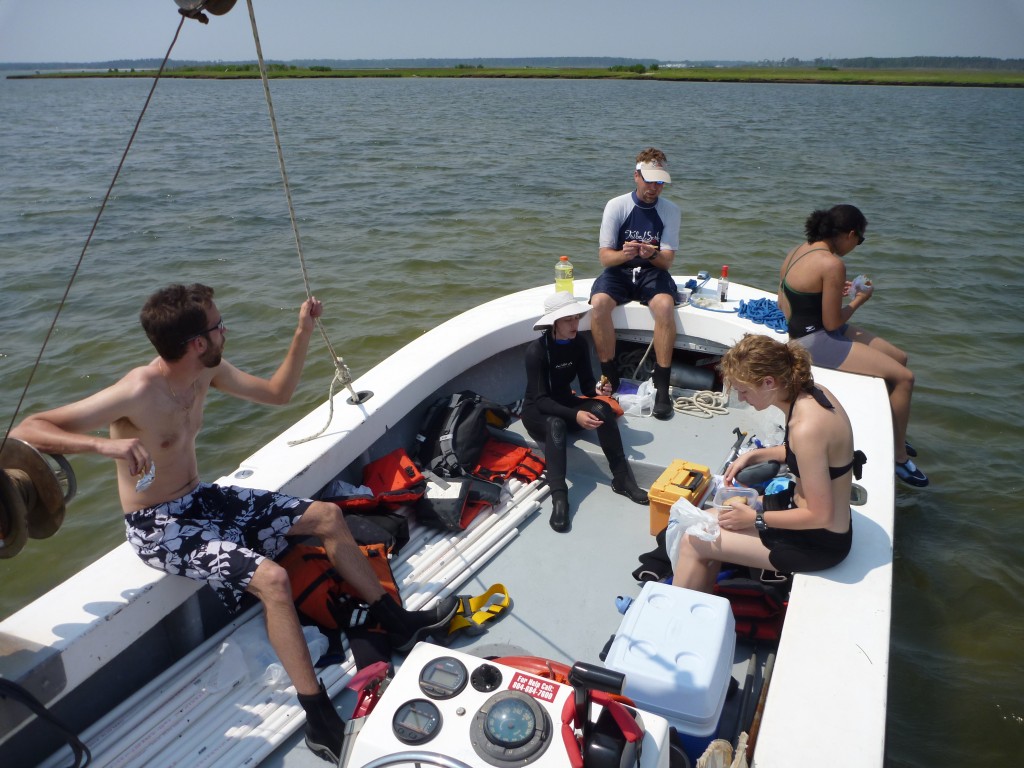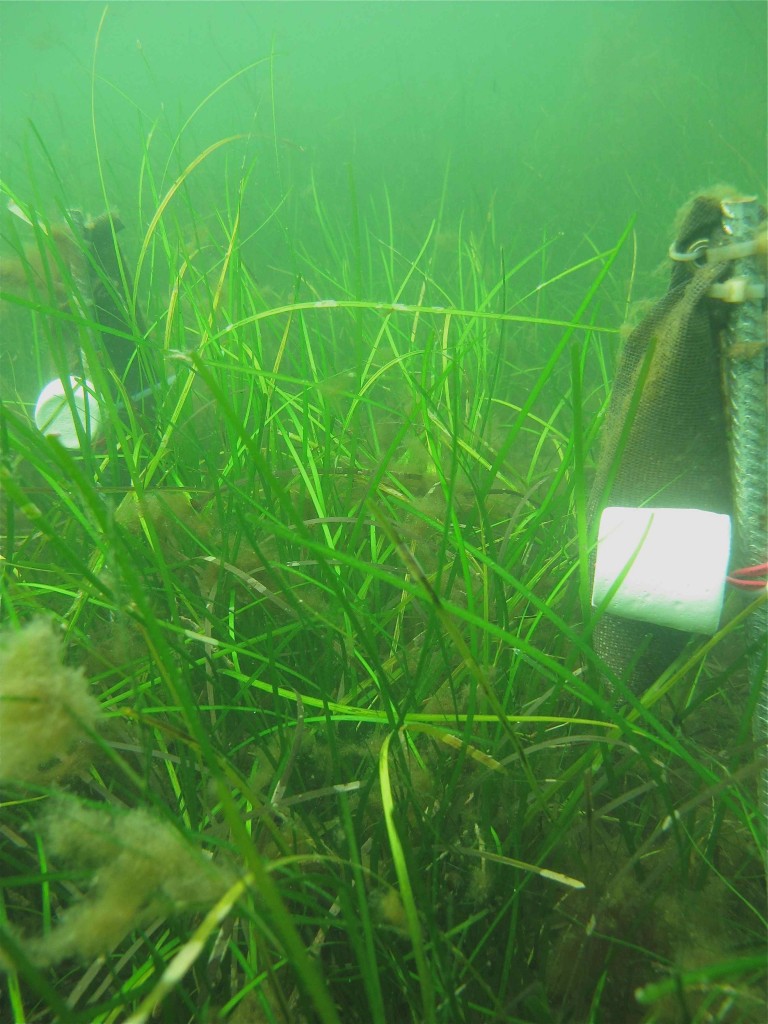A ZEN-like beginning in North Carolina
By Megan Gyoerkoe, UNC Chapel Hill undergraduate student
One morning, bright and very early, the North Carolina ZEN team packed up the truck and with all the necessary materials for the initial set up of all 40 experimental plots for our experiment. We arrived at our field site behind the Pine Knoll Shores Aquarium and the weather was absolutely beautiful, sunny and warm but with a cool breeze. The tide was calm and the Zostera seagrass beds were vast and lush. After briefly meeting with the aquarium staff our group got started right away, driving the 120+ poles needed to mark the experimental plots into the sediment. About half way through Pamela began to check some of the plots to make sure they had enough Zostera (we were aiming for a minimum of 80% cover). As it turns out what we thought were lush beds of Zostera were actually composed mainly of a different type of seagrass – Ruppia! You can understand that this is a problem given that we are working on the Zostera Experimental Network (ZEN) and not, well REN!
We had spent all morning driving poles into the sediment only to discover that we had been deceived by the seagrass. In disbelief that we could have made such a mistake, we checked and double-checked the plots. Then we went on an extensive Zostera hunt, searching endlessly for a hint of a healthy Zostera bed, swimming through the seagrass even under the threat of being hit in the face by jumping mullets! Turns out it was all in vain and it was back to the drawing board for the ZEN-NC site. What had been an extensive Zostera bed two years before had been replaced almost entirely by Ruppia and some Halodule seagrasses. We spent hours pounding in the poles only to pull them back up the next day.
Fortunately, Pamela, Erik and Rachel were able to work out the logistics for us to work at a new site nearby in Middle Marsh that was actually filled with beautiful, lush Zostera. Even though we had to re-set all of the poles, it turned out to be a wonderful, protected site that was a pleasure to work in.
Field research is definitely a category on its own; it is pleasantly unpredictable, entertaining, exciting and occasionally slightly torturous. Continue Reading
The ZEN Factory
By Paul Richardson, VIMS Marine Biodiversity Lab Manager
As Emmett’s lab manager in the Marine Biodiversity Lab at VIMS for the past 10 years there’s rarely been a dull moment. There is such an eclectic range of duties with this job that sometimes it’s hard to know what will come next. One day I may be driving a research vessel to field sites were we snorkel to collect samples in the Chesapeake Bay, the next I’m doing data analysis, or building materials for a mesocosm or field experiment, talking to a high school marine biology class, ordering lab supplies, or explaining to the woman at Wal-Mart that I really am buying all of their lingerie bags and knee high, queen sized, reinforced toe stockings for the purpose of science! The Zostera Experimental Network (ZEN) project has added yet more varied activities to the list. Never before have we conducted such an expansive project coordinating with 14 other research groups from around the States and the world!
First I have to say that none of this would have been possible without the hard work of the crew: volunteers Kara Gadeken, Megan Gyoerkoe, Jack Hawkins, and John Ray; our REU intern Akela Kuwahara and others; and the VIMS crew of Emmett Duffy, Pamela Reynolds, Erin Ferer, Jon Lefcheck, Nathan Bowman, and Elizabeth Bush. Marine ecology is a team sport and this crew knows how to play the game. Thanks! Also, I’m amazed to learn that it appears that all of the ZEN partners not only attempted but finished their experiments as well. As a first step, last winter we held a conference where representatives from all of the groups met in Williamsburg, VA to hash out a plan for the project. At this very productive meeting, it was great to meet all of the partners and certainly it was crucial to the success of the project. With Jim Grace’s seminars on structural equation modeling, Jim Thomas’ amphipod workshop, and all of the work sessions and other activities, the ZEN conference deserves its own dedicated post. As for me, after the meeting I worked with Emmett and Pamela to compute our materials needs, costs, vendors etc. for the network of ZEN experiments while also building on Matt Whalen’s work to formulate an ideal recipe and method for churning out the abundance of deterrent and control blocks that would be needed. I began conducting small field experiments to this end in the fall of 2010. In the spring after more trials we ultimately decided on a final mixture and we started churning them out. Continue Reading
This is science?
By Kara Gadeken, College of William & Mary undergraduate student
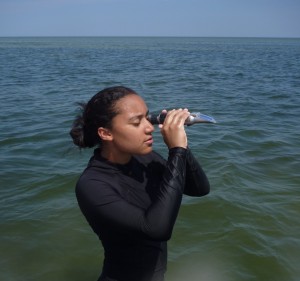
Undergraduate student Kara Gadeken takes water salinity measurements at Goodwin Islands, Virginia USA
Interning at VIMS during the hectic months when the ZEN project was at its peak was an experience that I will never forget.
The main reason that I wanted to take part in it was that, as an impassioned yet inexperienced college student, I had a reasonable knowledge base in biology but had no idea what it was like to actually do research, much less to be a part of such a grand-scale project as the ZEN. I approached Dr. Duffy at the suggestion of one of my professors at William and Mary, and luckily enough at this point his lab could use all of the help I could give.
I think the first thing that I realized while working in the Marine Biodiversity lab was that an insane amount of planning and preparation goes into research. Pamela had sticky notes and checklists and reminders all over everything in the lab, and two weeks of putting supplies together could count on one efficient day in the field. I also discovered that biologists, and especially experimental ecologists, almost have to have some engineering blood in them. In my first week at VIMS I sat in on a lab meeting to figure out how to design and construct cages to exclude predatory fish and crabs out in the seagrass beds. Time after time I heard, “How about this random thing? Hmm, I’m not sure that’ll work…How about this other random thing? Yeah, we can make something out of that!” Someone would hold up a piece of bent wire, some cable ties, bits of rope and mesh, some plastic plates. They hurled out idea after idea, trying to come up with something that could be constructed into a cage-like apparatus that would anchor into the sediment and withstand the waves. I remember stitching mesh together on an industrial sewing machine thinking, “This is science?” It didn’t take me long to realize that experiments are complicated. Not everything is perfect, and sometimes you have to work with what you’ve got, or make something new. Continue Reading
The dawn of ZEN
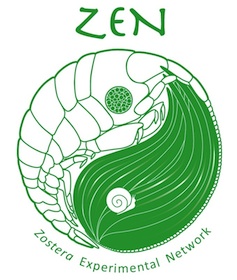 By Emmett Duffy, VIMS, ZEN Master
By Emmett Duffy, VIMS, ZEN Master
May I have the drum roll please . . .
Welcome, Ladies and Gentlemen, to the new official online home of the Zostera Experimental Network, known informally as ZEN. We are a global network of marine ecologists and evolutionary biologists from 15 sites (so far!) around the world, united in a quest to figure out how ecosystems associated with eelgrass (Zostera marina) work. The project has been seeded with generous support from the US National Science Foundation.
Eelgrass is one of the most widespread and important plants of the world’s shallow coastal seas and estuaries, ranging from above the Arctic circle to the balmy climes of Portugal, North Carolina, southern California, and southern Japan. ZEN has partner sites in all of those places. Extensive meadows of eelgrass support rich and productive biological communities of fish and shellfish, and provide important living buffers against storm and hurricane damage. As you might imagine, environmental pressures differ profoundly acros its broad range, from the glacial landscapes of northern Norway to the sweltering heat of the American southeast, as do the types of animals that live among the eelgrass. For these reasons, eelgrass beds are ideal candidates for exploring how gradients in environment and biodiversity influence the complex functioning of ecosystems.
ZEN is coordinated by myself and Dr. Pamela Reynolds at the Virginia Institute of Marine Science. We started officially in December of 2010 with a kick-off meeting that brought partners to Williamsburg, Virginia to plan strategy and finalize methods for our first big field experiment conducted in summer 2011.
On top of our day jobs, Pamela and I have been busy lately sorting the big trove of images from ZEN’s first global experiment in summer 2011, and wrestling with HTML code and other such arcana, in an effort to get the ZEN website up and running. There are still a few bugs to work out but we’re now pulling back the curtain, so voila! We hope you’ll find the site useful. For example you can find:
1) A list of ZEN’s participating partners and a little about the sites where they are working here. Stay tuned to the ZEN blog for updates on activities throughout the network.
2) A summary of the 2011 field experiment here — and first-hand accounts of the experiences of some of the students and others that participated here.
3) News of ZEN activities, publications, and research findings here.
And of course you can always leave a comment or send us an email using the little box at bottom of the page. Thanks for visiting. Y’all come back!

